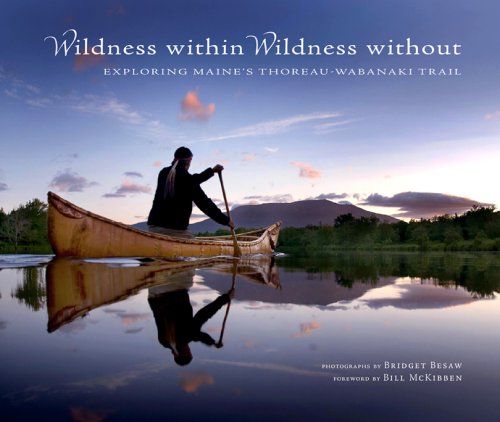Wildness Within, Wildness Without
by queen bee

Wildness Within Wildness Without: Exploring Maine's Thoreau-Wabanaki Trail, three different years in fact, is a huge photo coffee table size paperback that holds center stage in our living room here on Great Pond and in SC as well. Both homes show off the cover photo of a lone canoe paddler heading towards Mount Katahdin during a pastel sunrise or sunset. It steals the show on our Charleston marble top coffee table and our Marsden furniture that came with our old camp by the lake.
Bridget Besaw is the gifted photographer and Bill McKibben writes the foreword in this very exquisite publication, which is sold in Patagonia retail stores. Our son Matthew sent us this special Christmas gift from CA. Matthew has opened my eyes to the terrific outdoor books published by Patagonia and other prize-winning books sold on site at these clothing shops for outdoor ventures.
I discovered an old Down East Magazine that told the story of Yvon Chouinard, founder of Patagonia who was raised in Lisbon, Maine for eight years before his family moved to CA. Yes, this fast-growing business that honors environmental issues worldwide, has its roots in Maine. Patagonia has even sued President Trump over the Bears Ears National Monument land preservation and the current changes.
No doubt about it, this book will catch your eye: "This book is dedicated to the Wabanaki people, in whose footsteps Henry David Thoreau followed. May the wisdom of the trail inspire many more thoughtful travelers."
My husband Frank and I ventured to Greenville several summers ago. We found a motel and planned on taking the Katahdin steamer the next day on Moosehead Lake, enormous in size. We found a little restaurant with deliciously served fresh fish, so many meals there between walking the small town and after our voyage which took most of the day but covered less than half the lake.
A monument near the lake honored Henry David Thoreau, a beautiful sculpture. His three routes all converge at Bangor and Greenville. We boarded the steamer on the shorter tour that went almost to Mount Kineo, within sight before our tour returned to Greenville. Everywhere the shoreline looked undeveloped and natural in the great vastness of Moosehead.
Acquaintances at that favorite eating place in Greenville had spent their day in a canoe on a moose hunt. They found one with the help of their expert guide. Photos shared.
Walden is the book many of us read. Thoreau's experiment for a little more than two years in the woods where his small, one room house actually had occasional visitors. He was not too far from town, but he tried to isolate and wrote about this self-imposed experience.
Seems to me that these long travels so carefully documented in the North Woods of Maine are more of an experience of being "away" than his famous classic Walden. His journeys of 1846, 1853 and 180 reveal lengthy paths between villages and water routes of note.
Both Bangor and Greenville are the southern towns, parts of the great loop passages Thoreau returned to and branched out from. The campsites of the 1857 trail, his third exploration, is the most extensive, as far north as Eagle and Chamberlain Lakes.
Just studying the various maps and relating it to our small venture on the steamer, I wonder how Thoreau accomplished these three trails, even the shorter ones seem ever so long. Dates are superimposed on one map so you can understand the time it took Thoreau to explore.
[T]he wilderness that worried him most was the one inside, the most polluted by constant contact with a world where only man was present…The woods of Maine…is a place to start turning this around. This new trail will be haunted by…loon call and bear-scat."
Thoreau writes, "It is the lighting up of the mist by the sun."
Tom Slayton explains that Penobscot guides helped Thoreau in the 1850s: "The routes they followed are part of a much larger system of primeval waterways used by Native American peoples for thousands of years, both before Thoreau's journeys in the 1840s and 1850s and since."
This 2008 coffee table gem is also supplemented by a wonderful 2015 biography, The Queen Bee, the story of Roxanne Quimby, founder of The Burt's Bees business and giver of Maine land for monument and national park preservation.
Our Belgrade Public Library Book Group read and discussed this fine biography by Phyllis Austen, reviewed in Summertime a couple of years ago. A Maine author of accomplishment telling a comprehensive life story of an extremely successful Maine business woman who has chosen to buy up natural lands for preservation, for public use.
The photographic documentation of the trail(s), with its culmination as traveling exhibit and book, would not have been possible without the vision and generosity of Roxanne Quimby. Roxanne recognizes the importance of protecting our wilderness areas for their value as places that nurture our hearts, minds and bodies…I am thankful for this opportunity to grow creatively and spiritually while photographing these beautiful areas of Maine.
Online I found this precious book priced at $150, but of course, you can buy used copies for less. Come visit and look at my copy.
Other gifted writers within this photo book are: Neil Rolde, Maine Historian; Reuben "Butch" Phillips, Elder, Penobscot Indian Nation; Jennifer Barton, Project Coordinator, Maine Woods Forever Cherwonki Trip Leader; Garrett Conover, Maine Wilderness Guide, North Woods Ways; and Alan Hutchinson, Executive Director, Forest Society of Maine.
The book is a feast of a read with many Walden selections, too. The photos are full of Maine North Woods wonder explored and documented by H.D. Thoreau, writer extraordinaire.
<— Previous Article • Summaries • Next Article —>
©2020 by Summertime in the Belgrades. All rights reserved.

